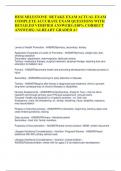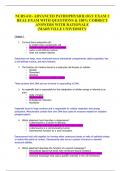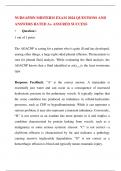HESI MILESTONE RETAKE EXAM ACTUAL EXAM
COMPLETE ACCURATE EXAM QUESTIONS WITH
DETAILED VERIFIED ANSWERS (100% CORRECT
ANSWERS) /ALREADY GRADED A+
Levels of Health Promotion - ANSWERprimary, secondary, tertiary
Application Examples of Levels of Promotion - ANSWERprimary- weight loss, diet,
smoking cessation
Secondary- papsmears, mammograms, testicular exams
Tertiary- medication therapy, surgical treatment, physical therapy, teaching foot care
education to diabetic care
Primary - ANSWERpromotes health and preventing development of disease process or
injury
Secondary - ANSWERscreening for early detection of disease
Tertiary - ANSWERbegins after illness is diagnosed and treatment. Aims to prevent
long-term consequences of chronic illnesses or disabilities
Nursing Assessments - ANSWERComprehensive- (Head to Toe) = Can be done
inpatient and through primary care (Physical assessment- annual exam)
Focused- Health and physical hx of specific problem.- ex. Sick visit
Emergency- crisis, life threatening. ex. airway, breathing, injury, disability, exposure,
med reconciliation
Phases of Interview process - ANSWERPre-interaction, beginning, working (open and
close ended questions), closing
Data sources - ANSWERPrimary- individual patient
Secondary- chart info, family members
Purposes of Documentation - ANSWERverbal communication, SBAR, written document
Lifespan Nutritional Considerations - Nutrition: Pregnant Women - ANSWERneed
additional 300-500 cal/day (whole foods
Lifespan Nutritional Considerations - Nutrition: infants/children -
ANSWERinfants/children: whole milk for ages 2-5 fat intake-brain development
, Lifespan Nutritional Considerations - Nutrition: Older - ANSWERBMR declines, Vitamin
D supplements, Problems: decreased thirst, increase risk for osteoarthritis,
osteoporosis, dementia, obesity, social isolation
General Survey - ANSWERmental note of overall health (hygiene/appearance).
Assessing pain: documentation, OLDCARTS/OPQRST. Aggravating and alleviating
factors, pain goal and funtional goal
Assessing Pain - Documentation - ANSWERAcute vs. Chronic-Location
Priority - ANSWERPriority pain: stones (kidney, gallbladder, calcium and/or struvite),
myocardial infarcation (HA), burns and sickle cell
Heart Rate Elevated - ANSWERabove 100 beats per minute
Blood Pressure- Normal - ANSWERabove systolic- 120-129, diastolic- less than 80,
Blood Pressure- elevated - ANSWERHypertension: Stage 1: 130-139 or 80-89, Stage
Hypertension 2: more than 140, or greater than or equal to 90
When should BP be taken? - ANSWERafter patient rests for 5 minutues or 30 minutes
after caffeine, smoking
Assessment of the Head and Neck - ANSWERInspect, palpate, auscultate
Infection - ANSWERIf nodes are palpable, warm, tender = infection
Assessment of the Ear - Techniques - ANSWERAdults: up and back
Children: down and back
Assessment of the Ear - Techniques Part 2 - ANSWERobserve behavioral responses to
speech, inspect ear formation (size, shape & any malformation to the auricle, condition)
Perform whisper test & Rinne test. Pt plug one ear at a time
Perform weber test (evaluate unilateral hearing loss
Assessing the Chest - ANSWERinspect, palpate, percuss, auscultate
Assessing Lung Sounds - Technique - ANSWERIPPA- inspect, palpate, percuss,
auscultate
Normal Lung Sounds - ANSWERNormal: bronchial (heard anteriorly) over larynx and
trachea (INSPIRIATION slightly shorter than expiration),
Bronchiovesicular (heard anteriorly and posteriorly)INSPIRATION AND EXPIRATION
EQUAL ,






